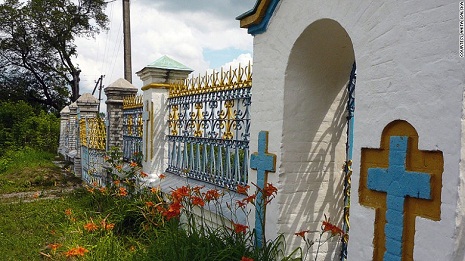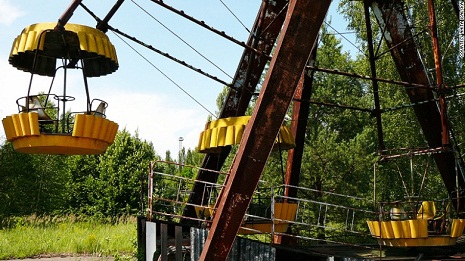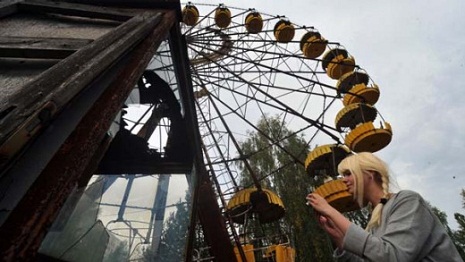Clouds of highly radioactive particles were released into the air during an attempted routine shutdown of the power plant north of Kiev in the former Soviet Union (now Ukraine).
Today, the number of tourists seeking to head deep into Chernobyl`s Exclusion Zone, a 30-kilometer radius of contaminated land around the power plant, supports several tour firms.
Even though recent instability in eastern Ukraine has pushed the country off most travelers` radars (budget carrier WizzAir recently announced the closure of its Ukraine subsidiary, severing some links), Chernobyl still looms large in the global consciousness.
Fears regularly circulating about the fallout zone, most recently over contamination via forest fires, seem to stoke just as much fascination, drawing a steady stream of tourists.
There are even hotels inside the Exclusion Zone.
Visits are governed by security checks and by strictly guided tours.
Visitors travel to the site, a two-hour drive north of Ukrainian capital Kiev, by tour bus.
Once there, they sign a disclaimer warning against touching any objects or vegetation, or even sitting on the ground.
Leaving the site is also highly regulated.
Body scanners test for high levels of radiation. If the scanner alarm sounds, guards sweep the individual for radioactive dust before they`re allowed to leave.

Frozen in time
The payoff is access to a city frozen in time.
The empty city of Pripyat, evacuated after the accident, is a snapshot of Eastern Europe before the fall of the Iron Curtain.
The zone`s post-apocalyptic atmosphere exerts a strong pull.
Rusting boats list in the River Pripyat.
A Ferris wheel stands motionless among steadily encroaching trees.
Traces of life in the former USSR are scattered everywhere, from children`s school books to Soviet propaganda posters.
The Chernobyl accident is ranked level 7, the highest on the International Nuclear Event Scale.
The severity of its widespread environmental and human cost has only been equaled by 2011`s disaster at Fukushima in Japan.
Contaminated rain and wind depositing radioactive dust were recorded as far afield as Sweden and Wales.
Research continues to examine the complex effects of increased exposure to radiation on ecosystems.
Chernobyl church still active
Memories of the human toll remain vivid, though precise numbers are disputed.
Official records give a death toll less than 50, many of them firefighters sent to tackle the blaze at the power plant.
But birth defects and thyroid cancer in Ukraine, as well as neighboring Belarus and parts of Russia, have been attributed to the accident.
Some studies link as many as 1,800 childhood cases of thyroid cancer to the Chernobyl accident.
The effects of the disaster on mental health in Ukraine and beyond are also coming to light.
Stigmatization of local people and relocation of communities is blamed for widespread depression and social problems.
But visitors who expect to find a charred, uninhabited wasteland are surprised when they enter the Exclusion Zone.
Far from being empty, power plant workers still commute into the zone.
A place of worship, the turquoise and white St. Elijah Church continues to welcome devotees.
Approximately 200 people still live inside the Exclusion Zone, despite government orders to leave.

Ghost town a "scattered snapshot" of old USSR
Peaceful meadows inside the zone suggest nothing out of the ordinary.
But tour guides hover Geiger counters over rusted debris littering the grass.
Background radiation around the Exclusion Zone can be up to 10 times the normal level.
Slow-growing vegetation, especially prone to absorbing radioactive particles, tests even higher.
The most intriguing part of the Exclusion Zone is the ghost town of Pripyat.
Founded two kilometers from the power plant in 1970, the city soon swelled to nearly 50,000.
Its entire population was evacuated after the disaster.
Now abandoned and overgrown, Pripyat still resembles a shattered snapshot of the typical Soviet city it once was.
Visitors crunch through broken glass and sidestep bushes sprouting through corners of apartment blocks.
Textbooks are strewn in empty classrooms and a chipped swimming pool lies empty beneath rotting wooden beams.
Traces of the former USSR are everywhere.
Vivid Soviet murals dance on walls.
Faded gas masks in children`s sizes lie in their dozens, a reminder of an era when fear of attack hung thick in the air.
"It is the preservation of Communist artifacts and atmosphere that people find so fascinating as well as the sad story behind it," says Dominik Orfanus,
Orfanus is a former tour guide of the fallout zone and now CEO of CHERNOBYLwel.come, a company arranging excursions to Chernobyl since 2008.
Photographer favorite
Such is the allure of Chernobyl to photographers that in 2012 a specific line of tours (chernobylphoto.com) was launched to meet the demand.
"The untouched scenery, wilderness, the contrast of the past and now, make Chernobyl really interesting for photographers," says Orfanus.
Pripyat`s amusement park is its most photographed area.
The park`s official opening had been planned for May 1, 1986, but the city was evacuated just days before.
Bumper cars, their yellow paint peeling, are at a standstill on cracked concrete.
The rusty funfair wheel has become almost iconic.
Barely used, the wheel has become a symbol of a once lively city silenced by disaster.
Though told the evacuation was temporary, Pripyat`s citizens never returned.
In the months afterward, some people returned to loot the site.
Chairs were torn out of a cinema and anything of value was hurried away.
The passing decades have seen nature encroaching into these once peopled spaces.
Drifters still turn up in Pripyat -- their calling cards are occasional beer bottles and cigarette stubs around the city.

Haunting graffiti, glimmers of meaning
More haunting is the graffiti that now punctuates the atmosphere in this quiet place.
Silhouettes of dancing figures are daubed on the walls of Pripyat`s buildings, perhaps an attempt to bring human life back.
In the months following the accident, a sarcophagus was built to cover Reactor 4 and contain the radioactive material.
Its other three reactors were still operational, but the last one shut down in 2000.
Efforts to contain the spread of radioactive particles continue to the present day.
A New Safe Confinement barrier is being built to replace the sarcophagus.
The final phase of construction is nearly underway, though reports suggest further funding needs to be secured.
The NSC is designed to contain radioactive waste and prevent further environmental contamination.
But curiously, increasing numbers of visitors to the area describe Chernobyl as a wildlife haven.
At first sight, Chernobyl`s untended greenery gives the impression of a place reclaimed by nature.
Shrubs burst through the floors and plants strangle window frames.
Much was made of a brown bear sighting in the fallout zone at the end of 2014.
Could nature be thriving in Chernobyl?
"There are severely depressed populations of most species in the contaminated areas," says Anders Pape Moller who has been researching Chernobyl since 1991.
Moller, a senior scientist at French national research organization CNRS, has observed that while cleaner areas within the zone aren`t impacted to the same degree, reduction in wildlife in contaminated areas is noticeable.
"You can hear it in spring because there are fewer birds singing. Like Rachel Carson`s `Silent Spring,`" he adds, referring to the classic 1962 environmental science book.
The effects of the Chernobyl nuclear accident on wildlife -- including higher rates of tumors and albinism in the local bird population -- continue to be recorded.
But the idea that natural forces can repair the damage wrought by humankind is powerful.
Many tourists to Chernobyl`s quiet meadows are seeking a glimmer of meaning.
But with statistics relating to Chernobyl hotly debated and the incident`s long-term effects still being measured, answers are hard to come by.
This ambivalence seems sure to continue holding Chernobyl`s visitors in thrall.
















































